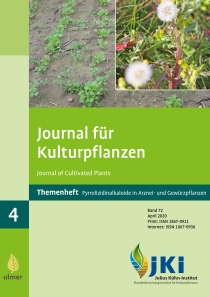Reduction of Pyrrolizidine alkaloids content in aromatic seed drugs – Regulation and Practice
DOI:
https://doi.org/10.5073/JfK.2020.04.08Keywords:
PA-contaminants, risk, regulation, minimization, seed drugs, mechanical separation, purityAbstract
The contamination of herbal teas with pyrrolizidine alkaloids (PA-s) and tropane alkaloids (TA-s), identified three years ago by the Federal Office for Risk Assessment, was a start point for many research studies on assessment and characterization of the risk as well as the development of methods for monitoring and minimization of the presence of PA-s in food and feed. During the same period, several Guidelines and regulation (Code of Practice) as well as Public Statements (EMEA) were drafted.
From the analysis of the available occurrence data and identification of potential risks along the entire process chain, Dr. Junghanns GmbH developed individual measures to significantly minimize the presence of PA-s and TA-s in aromatic seed drugs. Application of different mechanical separation processes on more than 100 batches (originated from the conventional and organic agriculture) of fennel, caraway, anise and other aromatic seed drugs shows how effective these measures were for the cleaning of highly contaminated batches. Possibilities and limits of different separation processes are explained using the examples of bitter fennel, sweet fennel, caraway and anise.
It was a particular challenge to move from the previous purity standard of 99% to a purity of 10 ppm and below. This goal was achieved in more than 90% of all cleaned batches after one or more passes. This proves that it is possible to minimize the content of PA-s and TA-s, making so many rejected batches marketable again.
Downloads
Published
Issue
Section
License
The content of the journal is licensed under the Creative Commons Attribution 4.0 License. Any user is free to share and adapt (remix, transform, build upon) the content as long as the original publication is attributed (authors, title, year, journal, issue, pages).
The copyright of the published work remains with the authors. The authors grant the Journal of Cultivated Plants, the Julius Kühn-Institut and the OpenAgrar repository the non-exclusive right to distribute and exploit the work.







